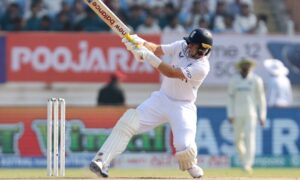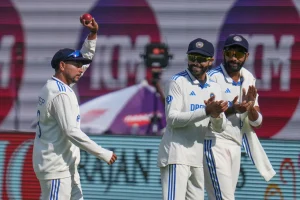
Ben Stokes made an honest confession after his team suffered an innings defeat in Dharamsala inside three days on Saturday. “Since the first Test match, we are man enough to say we have been outplayed,” said the England captain at the post-match presentation. The scoreline read 4-1 and it was a drubbing. The series provided a fascinating tale of an Indian comeback after losing the first Test in Hyderabad. The hosts missed some big players but their replacements stood up to be counted. In a series of fine margins until the fourth Test, India were resilient enough to win big moments and converted the opportunities into turning points.

Bumrah’s spell in Vizag
Down 0-1, India needed some inspiration. Batting first, they were 301-4 at one stage, but folded up for 396, giving England a chance to seize the initiative. At 114-2, the tourists were going well when Jasprit Bumrah took over. The wickets of Joe Root, Ollie Pope and Jonny Bairstow in quick succession changed the complexion of the game. The yorker to castle Pope – unarguably the ball of the series – dealt a psychological blow to England. And after Bumrah’s six-for, only one result was possible. Unlike the first Test, India weren’t going to make a hash of a big first innings lead again. Once they levelled the series, they smelt blood.
Root’s dropped catch
All fair and square at 1-1, India were batting first in the third Test in Rajkot. Suddenly, they found themselves at 33-3 and under some pressure. Rohit Sharma and Ravindra Jadeja took the score to 47, when the India captain was beaten by the turn from Tom Hartley and nicked the ball to Joe Root at slip. Root dived to his left but couldn’t cling onto the chance. It could have been 47-4 with an inexperienced middle-order to follow. Rohit went on to score his first hundred of the series and added 204 runs for the fourth wicket with Jadeja. It was a big turning point and India eventually won the Test by 434 runs.
For the Latest Sports News: Click Here

Root’s Baz-ramp
In the same Test, England made a rousing start to their first innings, racing to 224-2, going at nearly five-and-a-half runs per over. They looked to be in firm control, when Root reverse-ramped Bumrah (of all people) and holed out to Yashasvi Jaiswal at second slip. It was, perhaps, the worst shot of the series that gave India an inch. The hosts took a mile. England were bundled out for 319, giving India a first innings lead of 126 runs. The gap proved to be unbridgeable.
Duckett’s Baz-comment
As Jaiswal neared another double hundred, Ben Duckett praised the youngster, but added a pinch of salt to it. “When you see players from the opposition playing like that, it almost feels like we should take some credit that they are playing differently than how other people play Test cricket,” said Duckett. Seemingly a prisoner of his ignorance, the England opener was quickly corrected by Nasser Hussain. “He (Jaiswal) has not learnt from you. He has learnt from his upbringing, all the hard yards he had to put in growing up. If anything, lads, look at him and learn from him,” said the ex-England skipper on Sky Sports podcast. Duckett’s comment galvanised the young Indian team and helped create a siege mentality – us against them. No wonder, Rohit decided to rub it in ahead of the final Test, when he said: “There was a guy called Rishabh Pant in our team, probably Ben Duckett hasn’t seen him play.”
Jurel, the senior partner
Chasing England’s first innings total of 353 in the fourth Test in Ranchi, India were gasping for breath at 177-7. Dhruv Jurel, playing only his second Test, revelled under pressure. A 76-run eighth wicket partnership with Kuldeep Yadav ensued in which Jurel was the senior partner. He went on to score 90, cutting down England’s first innings lead to a very manageable 46. It changed the game on a wearing pitch, where the visitors were poised to get a lead in excess of 100.

Kuldeep’s second coming
His spell in the first innings in Rajkot was a curtain-raiser, when he had Jonny Bairstow and Duckett’s scalps to open the game for his team. It was important, for India were a bowler short after Ravichandran Ashwin had to leave due to a family medical emergency. Kuldeep raised the bar in the second innings in Ranchi, breaching Zak Crawley’s defence with a ripper and returning with 4-22. Both Ashwin and Shoaib Bashir bagged five-fors in that game, but impact-wise, Kuldeep was the best spinner on the show. The chinaman bowler built on that and returned with a five-for in the first innings in Dharamsala to trigger England’s collapse. He finished the series with 19 wickets at an average of 20.15, only behind Bumrah’s average of 16.89. The new version of Kuldeep is giving the ball a serious rip. He is bowling quicker through the air as well. The England batters couldn’t read him off his hand.
Rohit’s leadership
The skipper has a right to be exhausted. He was so much invested in planning England’s downfall. Rohit faced scrutiny after India lost the first Test in Hyderabad. He didn’t have the services of Virat Kohli, KL Rahul and Mohammed Shami to turn to. He refused to go back to Cheteshwar Pujara and backed the youth. The young team needed guidance at every turn and Rohit was there, creating the right atmosphere for the newcomers and always talking to them to help the Jurels and the Sarfarazs understand match situations better. Tactically also, he was superb. Ahead of the series, England had a camp in Abu Dhabi where they trained on four rank turners, assuming that they would get something similar in India. Rohit decided to play on slow turners instead, pitches that would have low bounce. It considerably increased the degree of difficulty for sweeps and reverse-sweeps. Pope’s magnificent 196 in Hyderabad aside, England batsmen struggled to adjust.
Also Read: Trailblazers Conclave 2.0 was a celebration of sport in totality




